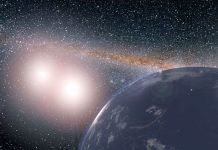
Have you ever wondered where all the different elements in the universe come from?
A team of researchers from the University of Michigan, led by Ian Roederer, has been digging deep into this question.
They’ve made some fascinating discoveries about how nature creates the heaviest atoms out there, and it all happens in the extreme environments of stars and supernovae.
Stars: The Cosmic Factories
Stars are like cosmic factories. They’re not just twinkling lights in the night sky; they’re busy producing new elements.
During their lifetime, stars work hard, fusing lighter elements into heavier ones.
This process is the reason why stars shine. But the story doesn’t end there. When a star dies, it sends these heavier elements back into space.
These remnants then become part of new stars, planets, and everything else in the universe, including us!
The Power of Supernovae and Neutron Stars
Some of the universe’s heaviest elements are born in spectacular events. In rare types of supernovae and in collisions between neutron stars (which are the dense cores of huge stars that have exploded), an incredible process happens.
In less than a second, a burst of neutrons transforms lighter elements into much heavier ones. This process, known as the “rapid neutron-capture process” or the r-process, is responsible for creating about half of the heaviest elements found on Earth today.
A New Discovery from Ancient Stars
Roederer and his team have been looking at old stars in the Milky Way, focusing on 42 of them where heavy elements made by the r-process are found.
By studying these stars together, they’ve noticed patterns that were not seen when looking at stars individually.
They found that the elements group into two categories: lighter ones like ruthenium, palladium, and silver, and heavier ones like gadolinium, dysprosium, and erbium.
The researchers think that these groups of elements were probably created when even heavier atoms split apart, a process called fission.
This fission would involve extremely massive atomic nuclei breaking into two. The elements they’re studying are likely the fragments left over from this splitting process.
Pushing the Limits of Atomic Heaviness
One key finding of this research is identifying the heaviest atom that nature can produce. The heaviest natural atom on Earth is uranium, with 238 protons and neutrons in its nucleus.
But this study suggests that stars can create an atom with at least 260 protons and neutrons. This is even heavier than the atoms created in nuclear weapons tests in the last century.
Looking to the Stars for Answers
Understanding how all this works is tricky. We can’t replicate these extreme cosmic conditions in a lab or even with nuclear weapons.
The only way to study these processes is by observing them in space. Roederer hopes that with tools like the James Webb Space Telescope, astronomers will soon be able to directly detect these heavy elements in space, especially in places like colliding neutron stars.
This study is not just about understanding stars and elements. It’s about using the cosmos as a natural laboratory to answer questions that were once thought unanswerable. It shows us a new way to learn about the universe, far beyond what we can achieve on Earth.
Source: University of Michigan.



